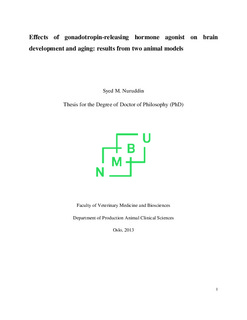| dc.description.abstract | Normal brain maturation is the result of many structural and molecular changes that can be modulated by endocrine variables and is associated with brain plasticity and sex- and age specific differences in cognitive performance. In many species, sexual dimorphisms in brain structure and function have been documented, some of which are present at birth but some of which develop post-natally. Using an ovine model, the work contained in this thesis demonstrates that a peri-pubertal pharmacological blockade of gonadotropin-releasing hormone (GnRH) action (by chronic treatment with a gonadotropin releasing hormone agonist (GnRHa)) results in increased sex-differences in emotional behavior and other cognitive functions. One of the aims of this body of work was to determine what changes in brain structure and function were present in such GnRHa treated animals. The hippocampus is the most investigated brain region with regard to the complex interaction of memory and spatial orientation, functions which are thought to be sexually differentiated.
The aim of the study described in paper I was, therefore, to investigate whether peri-pubertal GnRHa treatment had an effect on a hippocampus dependent cognitive task, namely spatial orientation and whether the pharmacological blockade of GnRH affected expression of hippocampal genes associated with endocrine signaling and synaptic plasticity. The GnRHa treatment had no significant effect on spatial orientation ability although there was a tendency of females to perform better than males; however, GnRHa treatment was associated with significant sex- and hemisphere specific changes in mRNA expression for some of the investigated genes. The aim of the study described in Paper II, was to investigate the effect of GnRHa treatment on structural development of the ovine brain such as total brain, hippocampus and amygdala volume using magnetic resonance image (MRI). Analysis revealed highly significant GnRHa treatment effects on the volume of the left and right amygdalae, indicating larger amygdalae in treated animals. Significant sex differences were found for total grey matter and the right amygdala, indicating larger volumes in male compared to female animals. Additionally, we observed a significant interaction between sex and treatment on left amygdala volume, indicating stronger effects of treatment in female compared to male animals.
The aim of the study described in Paper III, was to investigate the molecular mechanisms that underlie these GnRHa-induced morphological changes in the amygdala using Agilent ovine microarray technologies to identify genes affected by GnRHa treatment followed by qRT-PCR to verify the noted changes in gene expression. Gene network analysis was performed to predict the functional impact of the differentially expressed genes. The analysis demonstrated that GnRHa treatment was associated with significant sex- and hemisphere specific differential expression of genes in treated female, but not in treated male animals.
Recent studies have indicated an association between hormones of the hypothalamic–pituitary– gonadal (HPG) axis and cognitive senescence, suggesting that post meno-/andropausal changes in HPG hormones are involved in cognitive and neuropathological changes associated with aging such as in Alzheimer´s Disease (AD). GnRH and luteinizing hormone (LH) have long been shown to have central roles in reproductive physiology, however, GnRH receptors are also highly expressed in brain regions that are affected in AD (temporal-hippocampal cortex and limbic system), and thus age related changes in GnRH signaling could have an impact on amyloid deposits in AD. The aim of the study described in paper IV was therefore to investigate the effect of intervention with a GnRHa on amyloid plaque deposition and GnRH and GnRHR mRNA expression in a double transgenic mouse model that is predisposed to AD due to the presence of Arctic and Swedish amyloid beta (A4) precursor protein mutations (tg-ArcSwe). Analysis showed that the GnRHa/transgenes treatment clearly affects gene expression both at hormone and receptor level, while the effect GnRHa on amyloid plaque development remained unclear.
Overall, these findings substantiate the need for further studies investigating neurobiological effects of GnRH and the potential neurobiological side effects of GnRHa treatment on the brain in animals and humans. | |
